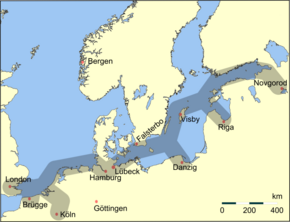Tallinn
| Tallinn | |||
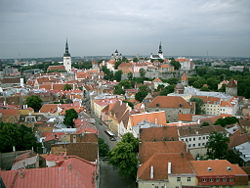 |
|||
|
|||
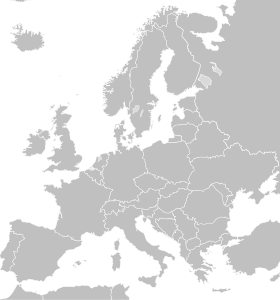 |
|||
| Coordinates: | |||
| Country | |||
|---|---|---|---|
| County | Harju County | ||
| First appeared on map | 1154 | ||
| Government | |||
| - Mayor | Edgar Savisaar | ||
| Area | |||
| - Total | 159.2 km² (61.5 sq mi) | ||
| Population (2007) | |||
| - Total | 400,911 | ||
| - Density | 2,506.9/km² (6,492.8/sq mi) | ||
| Time zone | EET (UTC+2) | ||
| - Summer (DST) | EEST (UTC+3) | ||
| Website: www.tallinn.ee | |||
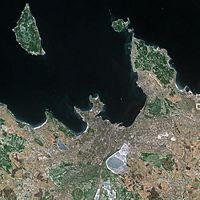
Tallinn (historically known by the German, Swedish and Danish name Reval or the Polish name Rewel, among other names) is the capital and largest city in Estonia. It lies on the northern coast of Estonia on the Gulf of Finland. The city is an important industrial, political and cultural center and seaport.
Contents |
Etymology
Historical names
The oldest names of Tallinn include Kolyvan (Russian: Колывань) known from Russian historical chronicles, the name deriving from the Estonian mythical hero Kalev. [1] [2]
The Scandinavians and Henry of Livonia in his chronicle called the town Lindanisa: Lyndanisse in Danish [3] [4], Lindanäs in Swedish, also mentioned as Ledenets in Old East Slavic. According to some theories the named derived from mythical Linda, the wife of Kalev and the mother of Kalevipoeg.[5] who in an Estonian legend carried rocks to her husband's grave that formed the Toompea hill. [6]
It has been also suggested that in the context the meaning of linda in the archaic Estonian language, that is similar to lidna in Votic, had the same meaning as linna or linn later on meaning a castle or town in English. According to the suggestion nisa would have had the same meaning as niemi (meaning peninsula in English) in an old Finnish form of the name Kesoniemi.[7]
Other than Kesoniemi known ancient historical names of Tallinn in Finnish include Rääveli.
In 1154 a town called Qlwri [8] or Qalaven (also Kalevan or Kolyvan) [9] [10]was put on the world map of the Almoravid by cartographer Muhammad al-Idrisi who described it as a small town like a large castle among the towns of Astlanda. It has been suggested that the Quwri in Astlanda may have noted the name of the city Kolyvan known also from the Russian chronicles that is today called Tallinn in Estonia [11] [12]
After the Danish conquest in 1219 the town became known in the German, Swedish and Danish languages as Reval (Latin: Revalia). The name originated from (Latin) Revelia (Estonian) Revala or Rävala, the adjacent ancient name of the surrounding Estonian county.
Modern name
The origin of the name "Tallinn(a)" is certain to be Estonian, although the original meaning of the name is debated. It is usually thought to be derived from "Taani-linn(a)" (meaning "Danish-castle/town"; Latin: Castrum Danorum) after the Danes built the castle in place of the Estonian stronghold at Lindanisse. However, it could also have come from "tali-linna" ("winter-castle/town"), or "talu-linna" ("house/farmstead-castle/town"). The element -linna, like Germanic -burg and Slavic -grad / -gorod, originally meant "fortress" but is used as a suffix in the formation of town names.
Tallinna replaced the previously used official German name Reval (Russian: Ревель) in 1918, when Estonia became independent. In the early 1920s, the official spelling of the city name was changed from Tallinna to Tallinn, making the new name notable since Estonian-language place names always end with a vowel (denoting the genitive case). However, somewhat confusingly to non-Estonian speakers, the word Tallinna still appears in modern Tallinn as the -a suffix can denote the genitive case (thus Tallinna Lennujaam translates literally as Tallinn's Airport).
History
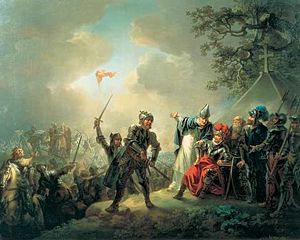

The first traces of human settlement found in Tallinn's city center by archeologists are about 5000 years old. The comb ceramic pottery found on the site dates to about 3000 BC and corded ware pottery c. 2500 BC[13]
In 1050 the first fortress was built on Tallinn Toompea.[9]
As an important port for trade between Russia and Scandinavia, it became a target for the expansion of the Teutonic Knights and Kingdom of Denmark during the period of Northern Crusades in the beginning of the 13th century when Christianity was forcibly imposed on the local population. Danish rule of Tallinn and Northern Estonia started in 1219.
In 1285 the city became the northernmost member of the Hanseatic League - a mercantile and military alliance of German-dominated cities in Northern Europe. The Danes sold Tallinn along with their other land possessions in northern Estonia to the Teutonic Knights in 1346. Medieval Tallinn enjoyed a strategic position at the crossroads of trade between Western and Northern Europe and Russia. The city, with a population of 8,000, was very well fortified with city walls and 66 defence towers.
A weather vane, the figure of an old warrior called Old Thomas was put on top of the spire of the Tallinn's Town Hall in 1530 that became the symbol for the city.
With the start of the Protestant Reformation the German influence became even stronger as the city was converted to Lutheranism. In 1561 Tallinn politically became a dominion of Sweden.
During the Great Northern War the Swedish troops based in Tallinn capitulated to Imperial Russia in 1710, but the local self-government institutions (Magistracy of Reval and Chivalry of Estonia) retained their cultural and economical autonomy within Imperial Russia as the Duchy of Estonia. The Magistracy of Reval was abolished in 1889. The 19th century brought industrialization of the city and the port kept its importance. During the last decades of the century Russification measures became stronger.


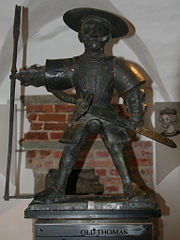
On 24 February 1918, the Independence Manifesto was proclaimed in Tallinn, followed by Imperial German occupation and a war of independence with Russia. On 2 February 1920, the Tartu Peace Treaty was signed with Soviet Russia, wherein Russia acknowledged the independence of the Estonian Republic. Tallinn became the capital of an independent Estonia. After World War II started, Estonia was occupied by the Soviet Union (USSR) in 1940, and later occupied by Nazi Germany from 1941-44. After Nazi retreat in 1944, it was occupied by the USSR again. After annexation into the Soviet Union, Tallinn became the capital of the Estonian SSR.
During the 1980 Summer Olympics a regatta was held at Pirita, north-east of central Tallinn. Many buildings, like the hotel "Olümpia", the new Main Post Office building, and the Regatta Center, were built for the Olympics.
In August 1991 an independent democratic Estonian state was re-established and a period of quick development to a modern European capital ensued. Tallinn became the capital of a de facto independent country once again on August 20, 1991.
Tallinn has historically consisted of three parts:
- The Toompea (Domberg) or "Cathedral Hill", which was the seat of the central authority: first the Danish captains, then the komturs of the Teutonic Order, and Swedish and Russian governors. It was until 1877 a separate town (Dom zu Reval), the residence of the aristocracy; it is today the seat of the Estonian government and many embassies and residencies.
- The Old Town, which is the old Hanseatic town, the "city of the citizens", was not administratively united with Cathedral Hill until the late 19th century. It was the centre of the medieval trade on which it grew prosperous.
- The Estonian town forms a crescent to the south of the Old Town, where the Estonians came to settle. It was not until the mid-19th century that ethnic Estonians replaced the local Baltic Germans as the majority amongst the residents of Tallinn.
Historically, the city has been attacked, sacked, razed and pillaged on numerous occasions. Although extensively bombed by Soviet air forces during the latter stages of World War II, much of the medieval Old Town still retains its charm. The Tallinn Old Town (including Toompea) became a UNESCO World Cultural Heritage site in 1997.
At the end of the 15th century a new 159 m high Gothic spire was built for St. Olav's Church. Between 1549 and 1625 it was the tallest church in the world. After several fires and following rebuilding, its overall height is now 123 m.
Geography
Tallinn is situated on the southern coast of the Gulf of Finland, in north-western Estonia.
The largest lake in Tallinn is Lake Ülemiste (covers 9.6 km²). It is the main source of the city's drinking water. Lake Harku is the second largest lake within the borders of Tallinn and its area is 1.6 km². Unlike many other large towns, the only significant river in Tallinn is Pirita River (a city district counted as a suburb). The river valley is a protected area because of its natural beauty.
A limestone cliff runs through the city. It is exposed, for instance, at Toompea and Lasnamäe. However, Toompea is not a part of the cliff, but a separate hill.
The highest point of Tallinn, at 64 meters above the sea level, is situated in the district of Nõmme, in the south-west of the city.
The length of the coastline is 46 kilometres. It comprises 3 bigger peninsulas: Kopli peninsula, Paljassaare peninsula and Kakumäe peninsula.
| Month | Jan | Feb | Mar | Apr | May | Jun | Jul | Aug | Sep | Oct | Nov | Dec | Year |
|---|---|---|---|---|---|---|---|---|---|---|---|---|---|
| Record high °C (°F) | 9.2 (49) |
10.2 (50) |
15.9 (61) |
27.2 (81) |
29.7 (85) |
31.2 (88) |
32.3 (90) |
31.2 (88) |
28.5 (83) |
21.8 (71) |
13.4 (56) |
10.7 (51) |
32.3 (90) |
| Average high °C (°F) | -2.9 (27) |
-3.0 (27) |
0.8 (33) |
7.3 (45) |
14.0 (57) |
18.8 (66) |
20.8 (69) |
19.9 (68) |
14.9 (59) |
9.0 (48) |
3.3 (38) |
-0.2 (32) |
8.6 (47) |
| Average low °C (°F) | -8.2 (17) |
-8.7 (16) |
-5.6 (22) |
-0.2 (32) |
4.9 (41) |
9.9 (50) |
12.5 (55) |
12.0 (54) |
8.0 (46) |
3.7 (39) |
-0.9 (30) |
-4.9 (23) |
1.9 (35) |
| Record low °C (°F) | -31.4 (-25) |
-31.0 (-24) |
-26.2 (-15) |
-17.2 (1) |
-4.3 (24) |
0.0 (32) |
4.4 (40) |
1.7 (35) |
-4.7 (24) |
-10.5 (13) |
-21.3 (-6) |
-32.2 (-26) |
-32.2 (-26) |
| Precipitation mm (inches) | 45 (1.77) |
29 (1.14) |
29 (1.14) |
36 (1.42) |
37 (1.46) |
53 (2.09) |
79 (3.11) |
84 (3.31) |
82 (3.23) |
70 (2.76) |
68 (2.68) |
55 (2.17) |
667 (26.26) |
| Source: Pogoda.ru.net[14] 7.09.2007 | |||||||||||||
Administrative districts
| District | Area | Population |
|---|---|---|
| Haabersti | 18.6 km² | 35,000 |
| Kesklinn | 28.0 km² | 34,985 |
| Kristiine | 9.4 km² | 27,531 |
| Lasnamäe | 30.0 km² | 108,644 |
| Mustamäe | 8.0 km² | 62,219 |
| Nõmme | 28.0 km² | 35,043 |
| Pirita | 18.7 km² | 8,507 |
| Põhja-Tallinn | 17.3 km² | 52,573 |
For local government purposes, Tallinn is subdivided into 8 administrative districts (Estonian: linnaosad, sg. - linnaosa). The district governments are city institutions that fulfill, in the territory of their district, the functions assigned to them by Tallinn legislation and statutes.
Each district government is managed by an Elder (Estonian: linnaosavanem). He or she is appointed by the City Government on the nomination of the Mayor and after having heard the opinion of the Administrative Councils. The function of the Administrative Councils is to recommend, to the City Government and Commissions of the City Council, how the districts should be administered.
Population

| Year | Population |
| 1372 | 3,250 |
| 1772 | 6,954 |
| 1816 | 12,000 |
| 1834 | 15,300 |
| 1851 | 24,000 |
| 1881 | 45,900 |
| 1897 | 58,800 |
| 1925 | 119,800 |
| 1959 | 283,071 |
| 1989 | 478,974 |
| 1996 | 427,500 |
| 2000 | 400,378 |
| 2005 | 401,694 |
| 2006 | 399,108 |
| 2007 | 400,911 |
Tallinn's population is registered 400,200 (as of May 2007).
According to Eurostat, the statistical agency of the European Union, of all EU member states' capital cities, Tallinn has the largest number of non-EU nationals: 27.8% of its population are not EU citizens. This is because colonisation from other Soviet republics during the period of Soviet occupation (1944-1991) brought large numbers of non-Estonians, mostly Russians, to Tallinn and other areas of Northern Estonia, and while those people and their descendants have been steadily naturalising, many -- by some estimates, around half of Tallinn's current ethnic Russian population -- have still not taken the route to citizenship.
| Nationality | Percentage |
|---|---|
| Estonians | 54.9% |
| Russians | 36.5% |
| Ukrainians | 3.6% |
| Belorussians | 1.9% |
| Finns | 0.9% |
| Others | 3.1% |
In addition to the native Estonian language (which is of the Finno-Ugric group, closely related to the Finnish language), Russian, Finnish and English are widely understood in Tallinn.
Economy
In addition to longtime functions as seaport and capital city, Tallinn has seen development of an information technology sector in recent years; in its 13 December 2005, edition, The New York Times characterized Estonia as "a sort of Silicon Valley on the Baltic Sea." One of Tallinn's sister cities is the Silicon Valley town of Los Gatos, California. Skype is one of the best-known of several Tallinn IT start-ups, and a first venture capital firm was founded in 2005. Many are housed in the Soviet-era Institute of Cybernetics, which is said to been one of the seeds for Estonian adoption of computing technology. Despite this, the most important economic sectors of Tallinn are the light, textile, and food industry, as well as the service and government sector. There is a small fleet of ocean going-trawlers that operate out of Tallinn.[15]
Education
Tallinn is the location of many institutions of higher education and science, including:
- Tallinn University (old name Tallinn Pedagogical University)
- Tallinn University of Technology
- Estonian Academy of Music and Theatre
- Estonian Academy of Arts
- Public Service Academy
- Estonian Evangelical Lutheran Church Institute of Theology
Tourism
Since independence, improving air and sea transport links with Western Europe and Estonia's accession to the European Union have made Tallinn easily accessible to tourists.
Estonia has made rapid economic progress since independence and this is reflected in local prices. Although not extortionate, neither are prices as cheap as in other former Eastern Bloc countries.

The main attractions are in the two old towns (Lower Town and Toompea) which are both easily explored on foot. Eastern districts around Pirita and Kadriorg are also worth visiting and the Estonian Open Air Museum (Eesti Vabaõhumuuseum) near Rocca al Mare, west of the city, preserves aspects of Estonian rural culture and architecture.
Toompea
This area was once a separate town (Dom zu Reval), the residence of the Chivalry of Estonia, Roman Catholic bishops of Tallinn (until 1561) and Lutheran superintendents of Estonia, occupying an easily defensible site overlooking the surrounding districts. The major attractions are the walls and various bastions of Castrum Danorum, the Russian Orthodox Alexander Nevsky Cathedral (built during the period of Russian Empire, the church was built on a site that formerly housed a statue of Martin Luther) and the Lutheran Cathedral (Toomkirik).
Lower Town


This area is one of the best preserved old towns in Europe and the authorities are continuing its rehabilitation. Major sights include Raekoja plats (Town Hall square), the town walls and towers (notably "Fat Margaret" and "Kiek in de Kök") and St Olaf church tower (124 m).
Kadriorg

This is 2 kilometres east of the centre and is served by buses and trams. The former palace of Peter the Great, built just after the Great Northern War, now houses (part of) the Art Museum of Estonia, presidential residence and the surrounding grounds include formal gardens and woodland.
The new residence of the Art Museum of Estonia: KUMU (Kunstimuuseum, Art Museum) was built several years ago.
Pirita
This coastal district is a further 2 kilometres north-east of Kadriorg. The marina was built for the Moscow Olympics of 1980, and boats can be hired on the Pirita river. Two kilometres inland are the Botanic Gardens and the Tallinn television tower.
Transport
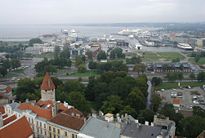

City transport
The city operates a system of bus (63 lines), tram (4 lines) and trolley-bus (8 lines) routes to all districts. A flat-fare system is used. Payment is made either by pre-purchase of tickets at street-side kiosks or by a purchase from the transport vehicle.
Air
Tallinn Airport is about four kilometres from Raekoja plats (Town Hall square). There is a local bus connection between the airport and the edge of the city centre (bus no. 2). The nearest railway station Ülemiste is only 1.5 km from the airport.
The construction of the new section of the airport has begun in 2007 and is scheduled to end in summer 2008.
There is an hourly helicopter service to and from Helsinki operated by Copterline. This route is advertised as the fastest capital-to-capital link in the world (one way takes 18 minutes). Copterline lost one of their helicopters in crash near Tallinn. This, together with decreasing amount of passengers and mechanical trouble with the one remaining helicopter, led to a decision to cancel the helicopter route. Flights restarted in 2008 with a new fleet[16]. The Copterline Tallinn terminal is located adjacent to Linnahall, only five minutes from the city center.
Rail and road
The Edelaraudtee railway company operates train services from Tallinn to Tartu, Valga, Türi, Viljandi, Tapa, Narva, Orava, and Pärnu. Buses are also available to all these and various other destinations in Estonia, as well as to Saint Petersburg in Russia and Riga in Latvia. The GO Rail company operates a daily international sleeper train service between Tallinn-Moscow and Tallinn-Saint Petersburg.
Tallinn also has a commuter rail service running from Tallinn's main rail station in two main directions: east (Aegviidu) and to several western destinations (Pääsküla, Keila, Riisipere, Paldiski, Klooga and Kloogaranna). These are electrified lines and are used by the Elektriraudtee railroad company. The trains are a mixture of modernised older Soviet EMU's and newly built units. The first electrified train service in Tallinn was opened in 1924 from Tallinn to Pääsküla, a distance of 11.2 kilometres.
The Rail Baltica project, which will link Tallinn with Warsaw via Latvia and Lithuania, will connect Tallinn with the rest of the European rail network. A tunnel has been proposed between between Tallinn and Helsinki, though it remains at a planning phase.
The Via Baltica motorway (part of European route E67 from Helsinki to Prague) connects Tallinn to the Lithuanian/Polish border through Latvia.
Frequent and affordable long-distance bus routes connect Tallinn with other parts of Estonia.
Ferry
- See also: Ports of the Baltic Sea
Several ferry operators, Viking Line, Linda Line Express, Tallink, Eckerö Line and Nordic Jet Line, connect Tallinn to
The most popular passenger lines connect Tallinn to Helsinki (80 kilometres north of Tallinn) in approximately 90 minutes by fast ferries or 2-3.5 hours by cruiseferries.
Former ferry operator SuperSeaCat declared bankruptcy in October 20, 2008.
Sister cities
Tallinn participates in international town twinning schemes to foster good international relations. Partners include:
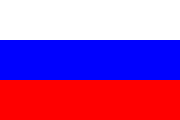 Saint Petersburg, Russia
Saint Petersburg, Russia Dartford, United Kingdom
Dartford, United Kingdom Los Gatos, United States
Los Gatos, United States Schwerin, Germany
Schwerin, Germany Kiel, Germany
Kiel, Germany Ghent, Belgium
Ghent, Belgium Gothenburg, Sweden
Gothenburg, Sweden Malmö, Sweden
Malmö, Sweden Riga, Latvia
Riga, Latvia Annapolis, United States
Annapolis, United States Groningen, Netherlands
Groningen, Netherlands Łomża, Poland
Łomża, Poland Gdańsk, Poland
Gdańsk, Poland Gdynia, Poland
Gdynia, Poland Białystok, Poland
Białystok, Poland
Tallinn also has a mutual friendship with the city of Portland, Oregon, United States and Kotka, Finland
See also
- Battle of Lyndanisse
- Castrum Danorum
- Evacuation of Tallinn (1941)
- Eurovision Song Contest 2002
- Legends of Tallinn
- Tallinn TV Tower
- Tallinn Marathon
- Tõnismägi
- Raeapteek
- Toompea
Gallery
References and Notes
- ↑ Terras, Victor (1990). Handbook of Russian Literature. Yale University Press. pp. 68. ISBN 9780300048681. http://books.google.com/books?id=VjKh2gkCudAC&pg=PA68&dq.
- ↑ The Esthonian Review. University of California. http://books.google.com/books?id=-D9DAAAAIAAJ&q=%22the+old+Russian+name+for+Reval+has+been+retained+(Kolyvan+from+Kalev)%22&dq=%22the+old+Russian+name+for+Reval+has+been+retained+(Kolyvan+from+Kalev)%22&ei=LRUISeivAaX2MaLHpJwB&client=firefox-a&pgis=1.
- ↑ (Danish)In 1219 Valdemar II of Denmark, leading the Danish Fleet in connection with the Livonian Crusade, landed in an Estonian town of Lindanisse [1] SALMONSENS KONVERSATIONS LEKSIKON
- ↑ (German) Reval's ältester Estnischer Name Lindanisse, Verhandlungen der gelehrten estnischen Gesellschaft zu Dorpat. Band 3, Heft 1. Dorpat 1854, p. 46–47
- ↑ Wieczynski, oseph (1976). The Modern Encyclopedia of Russian and Soviet History. Academic International Press. pp. pp.230. ISBN 9780875690643. http://books.google.com/books?hl=en&q=%22the%20Scandinavians%20called%20it%20Lindanisa%20after%20Linda%2C%20the%20mother%20of%20Kalev%22&um=1&ie=UTF-8&sa=N&tab=wp.
- ↑ Ransome, Arthur (1923). "Racundra's" First Cruise. B.W. Huebsc. http://books.google.com/books?q=%22The+old+giant+Kalev+died+here+at+Reval%2C+and+Linda+heaped+stone+after+stone+upon+his+grave+and+so+made+that+proud+hill%22&btnG=Search+Books.
- ↑ VIRKKUNEN, A. H. (1907) (in Finnish). ITÄMEREN SUOMALAISET SAKSALAISEN VALLOITUKSEN AIKANA. Suomen Muinaismuistoyhdistys. pp. 91. http://books.google.com/books?id=OK4MAAAAYAAJ&pg=PA91.
- ↑ Fasman, The Geographer's Library, pp.17
- ↑ 9.0 9.1 Ertl, Alan (2008). Toward an Understanding of Europe. Universal-Publishers. pp. 381. ISBN 9781599429830. http://books.google.com/books?id=X9PGRaZt-zcC&pg=PA381.
- ↑ Birnbaum, Stephen (1992). Birnbaum's Eastern Europe. Harper Perennial. ISBN 9780062780195. http://books.google.com/books?source=ig&hl=en&rlz=&=&q=%22who%20called%20the%20settlement%20Kolyvan%22&um=1&ie=UTF-8&sa=N&tab=wp.
- ↑ Fasman, Jon (2006). The Geographer's Library. Penguin. pp. pp.17. ISBN 9780143036623. http://books.google.com/books?id=bE2oerrW_IkC&pg=PA17&dq.
- ↑ "A glance at the history and geology of Tallinn" by Jaak Nõlvak. In Wogogob 2004: Conference Materials
- ↑ Alas, Askur. "The mystery of Tallinn's Central Square" (in Estonian), EE. Retrieved on 2008-10-29.
- ↑ "Pogoda.ru.net" (in Russian). Retrieved on September 7, 2007.
- ↑ http://www.iec.is/reyktal.htm Reyktal AS fleet
- ↑ Copterline web page
- Mark Landler, "The Baltic Life: Hot Technology for Chilly Streets", The New York Times, December 13, 2005
- Scooch 'Flying the Flag (For You)', Warner Music UK, 2007 Eurovision Song Contest Entrant [UK]
External links
General
Travel
Maps
Other
- Tallinn at the Open Directory Project
- Soviet, Estonian and German Memorials and cemeteries in Tallinn at sites-of-memory.de
|
||||||||||||||||||||||||||||
|
||||||||||
|
||||||||||||||||||||||||||
|
|||||
|
|||||
|
|||||
|
||||||||||||||||||||





